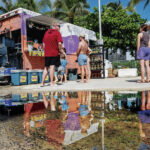HTA seeking to shore up tourism with new round of emergency funds


The Hawaii Tourism Authority has declared a continued tourism emergency, and for only the second time since its creation in 1998 is seeking approval to use its $5 million Tourism Emergency Special Fund to shore up the industry, which is still in recovery mode.
HTA first used its emergency fund in 2023 after Gov. Josh Green declared a state of tourism emergency through his sixth emergency proclamation related to the Maui wildfires. The proclamation authorized HTA for the first time to utilize the fund, which is designed to provide emergency relief under Hawai‘i Revised Statutes 201-B 10.
The agency used $2.85 million of the first emergency fund, release in 2023, on a marketing recovery campaign. The campaign ran after the devastating Aug. 8, 2023, Maui wildfires and was designed to boost U.S. arrivals.
A portion of that amount also was used to cover shelter and luggage expenses for visitors who were stranded by the fires.
HTA used an additional $2.125 million of the emergency funding in 2024 on various recovery initiatives identified in its board-approved Maui recovery plan to bring visitors to the Valley Isle and support Maui’s businesses and residents.
Board Chairperson Mufi Hannemann said HTA has requested $5 million more in emergency funding to be used on additional recovery initiatives and saturation campaigns. He praised the effectiveness of a Los Angeles saturation campaign held in September when HTA contractor Hawai‘i Visitors and Convention Bureau and other partners helped HTA aggressively flood the market with Hawaii branding.
He said HTA wants to return to Los Angeles and also conduct a San Francisco saturation campaign.
“HTA is still working hard to encourage short-term domestic travel and rebuild our international demand in a competitive global marketplace,” Hannemann said. “Our activation in Southern California and additional Maui marketing helped adjust the trajectory as we closed out 2024. We’ll keep working with our board, Gov. Green and the Legislature to make sure we can keep doing work in our key markets, like more activations and partnerships and sports events to reach prospective travelers.”
Quick-return strategies
Hawaii faced declining visitor arrivals in 2024 due to myriad factors, including the aftermath of the Maui wildfires, strong competition from other destinations and unfavorable currency exchanges that hit international visitors hard, especially those from Japan, which is Hawaii’s top international market.
Daniel Naho‘opi‘i, HTA interim president and CEO, said at the Dec. 19 HTA board meeting that the agency is still working through the objectives and goals for a five-year plan, with this fiscal year leading into the rest of the calendar year focused on market recovery, and the years after that solidifying destination management and stewardship plans for each island.
“We continue to stabilize our important markets. That means recovering demand from the U.S. and Canada, which were particularly impacted by the Maui wildfires,” Naho‘opi‘i said. “We also continue to rebuild our international markets.”
He said the agency’s global marketing teams have been directed to attract visitors to Hawaii while ensuring they have enriching experiences that help them form deeper connections with the islands.
In this market recovery phase, HTA is focused on quick-return marketing strategies, such as market saturation activations and co-op programs, which has included participation from the broader tourism industry.
HTA has been budget-challenged in recent years and continues to see a need to tap into emergency funds in 2025 so that it can support efforts that are essential for stabilizing the domestic market and rebuilding international interest.
The agency transmitted its latest request to tap into emergency funds to the state Department of Business, Economic Development and Tourism, to which it is attached for administrative purposes. From there, the request must go to the state Department of Budget and Finance and the governor for final approval.
If approved, the request is in addition to HTA’s bid to get the state Legislature to consider increasing its current $63 million appropriation to $80 million.
Though the $80 million request approved by the HTA board is far below earlier funding levels, attaining it won’t be easy.
DBEDT Director Jimmy Tokioka said he cut HTA’s budget request for the next fiscal year to $70 million after feedback from state Director of Finance Luis Salaveria and Green, and from the HTA board’s Budget and Finance Committee.
“I was told to hold the line, but it was my position that we had some programs that needed a little bit of a boost,” Tokioka said.
Keith Vieira, principal of KV & Associates Hospitality Consulting, said pockets of the tourism market remain weak and that warrants bolstering HTA’s regular budget, which depends on transient accommodation tax collections and isn’t keeping up with inflation.
He said tapping into emergency funds again also would allow HTA to increase its impact, which is “crucially important” given the current downturn.
“It’s not so much that the state has to pay for things, but it’s the incubator that drives the industry,” Vieira said. “For instance, HTA paid about $1.5 million for the Los Angeles saturation, and I’ve heard that the industry chipped in another $11 million to $12 million.”
Drop in top markets
November brought more visitors to Hawaii than the year before; however, during the first 11 months of 2024, the state’s tourism performance was still falling short of the prior year, in keeping with the lackluster year-end finish that economists had anticipated.
DBEDT reported Tuesday, when it released preliminary statistics for November, that the visitor industry recorded its fourth consecutive year-over-year growth for the month. Some 770,940 visitors came to Hawaii in November and spent $1.55 billion, up 5.3% and 2%, respectively.
For the first 11 months of 2024, nearly 8.78 million visitors came to Hawaii, which was down .2% from the first 11 months of 2023, DBEDT reported. Visitors during the first 11 months of 2024 spent nearly $18.64 billion, a decline of 0.8% from the first 11 months of 2023.
Results from DBEDT’s interactive data dashboards show that most of the state’s top domestic and international visitor source markets were down through the first 11 months of 2024, underscoring current challenges, and points to why DBEDT’s latest tourism quarterly forecast anticipated that visitor arrivals in 2024 compared to 2023 would fall 0.6% to 9.6 million arrivals and spending would drop 1.4% to $20.57 billion.
The dashboards indicate that eight of the state’s top 10 domestic visitor source markets during the first 11 months of 2024 were trailing the same period in 2023, including California (down 1.8%), Texas (down 4%), Oregon (down 2.8%), Arizona (down 0.4%), Colorado (down 4.8%), Florida (down 1.3%), Nevada (down 0.7%) and Illinois (down 5.7%).
Only two of Hawaii’s top 10 domestic visitor source markets were up during the first 11 months of 2024: Washington, which rose 2.2%, and Utah, up 2.1%.
Japan recovery slow
The dashboards also show that eight of the state’s top 10 international visitor source markets during the first 11 months of 2024 were likewise trailing the same period in 2023, including Canada (down 8.9%), Oceania (down 13.8%), other Asia (down 16.9%), Australia (down 10.4%), Korea (down 3.3%), Europe (down 22.1%), New Zealand (down 26.5%), China (down 54%) and Taiwan (down 78.6%).
Only two of Hawaii’s top 10 international visitor source markets increased during the first 11 months of 2024: Latin America, which rose 2.1%, and Japan, which increased by 25.2% mostly because its recovery has lagged other markets.
Eric Takahata, managing director of HTA marketing arm Hawai‘i Tourism Japan, said, “Our key source markets domestically and our international markets like Japan, which is the top international market, would benefit from greater marketing.”
Takahata said the Japan market is trending up but that full recovery still is expected to take a few years.
“We are expected to finish the year with about 700,000 arrivals from Japan — a little less than half of the 2019 level when we had 1.56 million arrivals,” he said. “Next year, we should finish about 30% to 40% above the 2024 level, which would put us at about 1 million visitors from Japan.”
Takahata said traveling to Hawaii became more convenient for Japanese travelers after the global entry and mobile passport control programs took effect in the later part of last year. However, he said, monetary challenges from a weak yen to the dollar and U.S. inflation continue to hamper recovery, as does competition from other destinations that are investing more in their tourism products and marketing campaigns.
“We’re looking at a 30% reduction in our 2025 budget because of HTA’s budget limitations. We aren’t even keeping up with the Joneses or the Tanakas, and the costs are rising,” he said.
“We do have things in place like you saw with the Los Angeles saturation. We want to put more resources into working on initiatives at a holistic level that address challenges like the unfavorable exchange rate. If we had more resources, we would use the additional funding to add more value to the Japanese visitor experience.”



